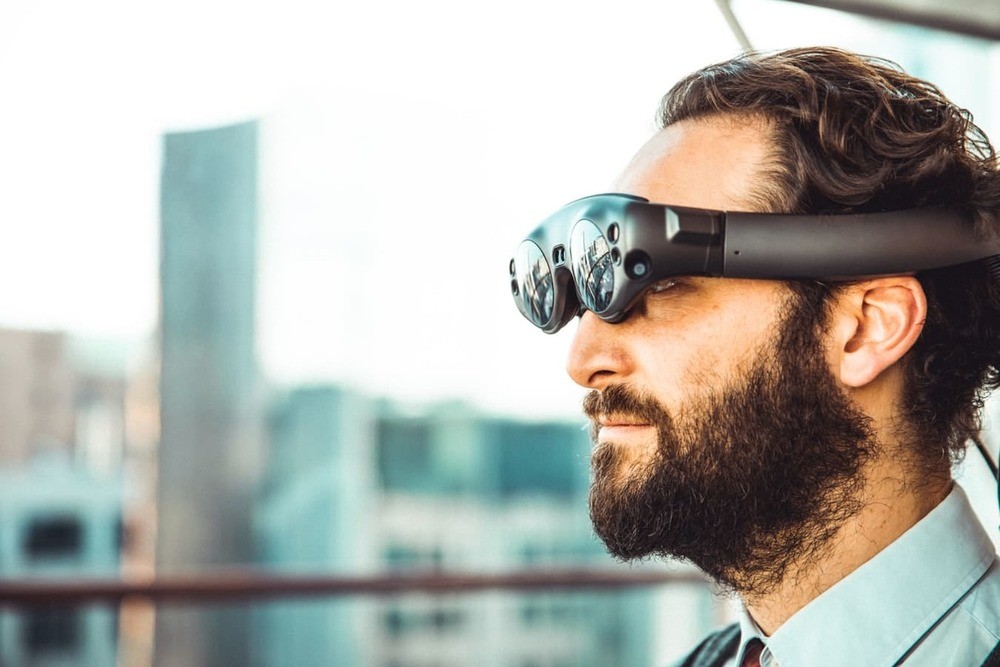While VR is changing the entertainment industry, AR is helping in the transformation of business processes. Manufacturing is one of those spheres where AR provides valuable input: Product development and quality assurance, equipment maintenance and work training – you can handle all of it with ease.
The number of manufacturers interested in AR equipment is growing, and we’ve decided to demonstrate its benefits and applications for your business. Do you want to know how augmented reality is being used in manufacturing?
Let’s start exploring the ways it can transform the everyday routine of your employees and increase your income.
How will you benefit with AR in manufacturing?
Imagine how AR may look like in the daily routine of a worker in the manufacturing industry. For example, they are examining a piece of equipment and see its size or current temperature in numbers that “float” above it. No extra manuals, tools to use, or time to spend on calculations – you have all this data right in front of you.
Even though we haven’t started to number augmented reality use cases in manufacturing, some of its strong sides are striking the eye already.
The main benefits of AR in manufacturing include the following:
- Improved productivity. When there is no need to use additional manuals and instructions to build a product, you save a lot of time and create more items much faster.
- Decreased costs. Such problematic issues as production downtimes and emerging errors are pressure points for any manufacturer. With AR equipment, technicians can quickly identify the flaw and save a lot of production time.
Plus, some of the errors won’t occur as the production process is aided by AR devices (for example, when a virtual image of the product is compared to the ready-made sample).

- Data is easily accessible. Information about any object in the workplace, which includes its location and specifications, can now be stored in one resource planning system. It saves time and optimizes work processes.
- Faster working. AR equipment greatly contributes to any stage of product development, employee training, or maintenance. There is no need to consult any additional manuals, instructions, or specifications – AR sensors and cameras replace all of it, which saves lots of time when completing various tasks.
- A higher level of safety. AR equipment provides additional information about any object. When workers put on AR headsets, they can see the object’s temperature, level of danger, and whether it has any damages or not. Consequently, technicians are well-informed and work in a safer environment.
And there are more points in this list. In the IDC white paper published in 2018, the top 3 reasons for interest in AR for business are
- more hands-free work
- improved interactions with clients
- result-oriented processes with remote access
Here is the graph with all the options:

At the same time, the primary AR use cases in manufacturing include
- production line training
- production line service
- team collaboration

Let’s now look through examples of the most popular augmented reality uses in manufacturing. You’ll see that some of the most prominent companies have already implemented advanced technologies in their work environment.
7 ways to use AR in the manufacturing industry
Building more products and decreasing expenses – that sounds great for most business owners. The question is, how exactly can entrepreneurs achieve it? These use cases will help you get all the answers you need, and will put you on the right path toward transforming your business with AR.
1. Product design and development
These are resource-consuming processes that usually involve the collaboration of several departments. Communication is one aspect which takes time and, consequently, increases the overall development period.
Ford’s Designers are now using AR to improve productivity in manufacturing by adding potential design elements to an already existing prototype, as well as comments and remarks. Ultimately, Ford workers get more space for their creativity and improve their communication channels.

2. Complex assembly
Workers traditionally use printed instructions to build a piece of equipment. As a result, it takes time to consult the manual, and furthermore, such documents should be always up to date. Augmented reality in the manufacturing industry solves these problems as workers see the data in the work field in real time.
Boeing simplified their wire assembly with Google Glass (AR headsets). They not only provide a means to review instructions but also make requests via voice commands and video streams with colleagues.
3. Quality control
Another reason why you lose profit is because of product returns. In this case, quality stands above all. To make sure the product meets the initial requirements, workers should compare them and highlight any mismatch during each stage of production. The human factor increases the risks, but augmented reality in manufacturing can help you eliminate them.
Read also: Industrial IoT Security: How to Protect Smart Manufacturing

In 2016, Porsche introduced its new AR approach to the QA process. Technicians could see the original product design as a 3D model next to the ready-made prototype. The ability to record the checking process and save it to the cloud for the development team was also made possible.
4. Streamlined logistics
Managing orders is a tedious task, as it includes several steps completed one by one. Let’s say there is a new order coming. First, a worker should check the database, then find the product that has been ordered, scan it, prepare the product for delivery, and finally, sign the product off. It’s too much to do even though it seems simple, right?
Read also: How to Optimize Supply Chain Through IoT, Analytics and Automation
With AR, the whole process is streamlined. DHL’s management decided to test it out three years ago, in August 2016. Workers simply scan (with their AR headsets) trolleys with products, then particular items from that trolley, and place those items into the correct trolley boxes.
AR does not require a lot of training to start using it, and workers’ hands are freed up from extra papers or devices.
5. Equipment maintenance
Overlooking problems and errors is a common issue for all maintenance crews. AR will help you identify where exactly the problem is and eliminate the risks that can emerge in the future.
Read also: Connectivity of Legacy Equipment: The Transformation of Manufacturing

Mitsubishi Electric announced developing AR-based 3D models to use in maintenance and support. This is how it works: with headsets on, technicians see the order of each inspection in 3D and then add the results with voice commands. It reduces the time for monitoring and helps reduce entry errors.
6. Workforce training
Training and informing new workers does not necessarily require the time of experienced technicians. With AR technology, a newcomer knows how and where to place the necessary product elements. It concerns even the most complex and innovative production processes.
Lockheed Martin, a defense contractor, provides team members with instructions and holographic elements available with Microsoft AR headsets. Previously, workers spent nearly 50% of their time checking and double-checking the manuals, which is a lot when you are building a spacecraft. Imagine how the workflow can be optimized within a smaller production company.
7. Expert support
There are many branches where technical support is crucial even when the product is ready. In some cases, experts need to travel many miles to the machinery to check and fix occurring problems.
It means the world for business owners – their workers spend a lot of time traveling to the required location to finish the work there. This problem can be solved by hiring dozens of tech experts, but what if things go wrong unexpectedly on the other side of the world? That’s when AR appears on stage.
Leybold created an app that helps users maintain equipment even if they have zero expertise. With AR, a common repair problem can be visually displayed and fixed readily – it prevents downtimes and saves repair spending.
Should you implement AR at your company?
Now you know how to use AR in manufacturing, and you may be eager to pursue it. Keep in mind, however, there is always the other side of the coin. All types of innovative technologies require investments on time and money, so you should think carefully before getting down to business.

But to keep your thoughts moving forward with AR, there are some alarming signs that we would like to point out, which may make you consider implementing augmented reality immediately:
- A highly-competitive market. Your closest competitors are fighting for their customers as much as you are. It means the improvement of processes and reduction of production time is a number-one priority for dozens of branches and industries, and AR is the helping hand in this fight.
- Frequent production downtimes. When at least one element of a long chain stops, you’re losing your time, profit, and market share – it’s unacceptable in manufacturing. If you want the production process to be fast and smooth, focus on production upgrades.
- A growing number of errors. The human factor is an integral part of any workplace. But if you notice that equipment damages are often overlooked, then AR headsets are indispensable radars that can help your workers be on the lookout.
- Considerable time needed to teach and train employees. If your company grows or starts using new equipment, teaching your workers may take longer than you think. AR devices will greatly assist you eliminate risks and improve productivity.
Overcome challenges, gain opportunities
AR is not a plot twist of a sci-fi movie – it is an opportunity that we should take advantage of now. Augmented reality will certainly become an inseparable facet of the manufacturing industry and help entrepreneurs save time and money on every production stage.
Forget about long hours studying manuals and instructions, ease up collaborations between company departments, and do not spend extra money on risks and errors – that is how augmented reality is being used in manufacturing today. All of it is possible with AR headsets, and of course your enthusiasm. In other words, the future is waiting. Are you ready to join?
Eastern Peak is your reliable partner when it comes to software development of any complexity. Got an AR app idea for your company? Drop us a line to discuss the details.
Read also:




